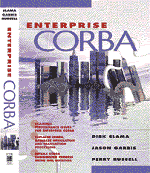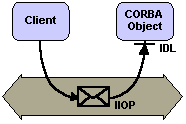|
CORBA
-- The IT garage
Enterprise CORBA comes to Japan
 Why is there no space
for cars in the garage of your average American family? Because Americans tend
to use their garages as a storage room, piling up useful things like the lawnmower
with the dull blade or the inflatable pool with the small hole in it. Nobody would
ever consider throwing away these valuable assets, and the further back in the
garage, the safer they are from ever being touched again. CORBA helps organize
your company's IT garage.
Why is there no space
for cars in the garage of your average American family? Because Americans tend
to use their garages as a storage room, piling up useful things like the lawnmower
with the dull blade or the inflatable pool with the small hole in it. Nobody would
ever consider throwing away these valuable assets, and the further back in the
garage, the safer they are from ever being touched again. CORBA helps organize
your company's IT garage.
In a sense, most
company's IT departments resemble an American family's garage: an IT system that
was introduced once is almost never thrown away. These systems contain enormous
amounts of business logic, which are too expensive to replace. Additionally, many
of these systems are so intertwined that it is impossible to touch one without
affecting at least five others.
The past few decades
have seen many generations of new technologies, including operating systems like
MVS, Unix, and NT; database management systems like ISAM, RDBMS, and OODBS; and
programming languages like COBOL, C, C++, and Java. And the next generation of
hot new technology is already lurking around the corner.
In the 1980's,
the IT industry tried to agree on common standards for operating systems, network
protocols, and application platforms. Unfortunately, this "age of consensus" produced
few commercial products that faithfully adhered to these standards. In the late
1980's, the OMG (Object Management Group) started to address the open systems
dilemma by defining a framework which focused on technology integration, leaving
the door open for many diverse technologies to be integrated. This technology
framework -- called CORBA (Common Object Request Broker Architecture) -- arguably
has become one of the largest and most important recent undertakings in today's
IT field.
CORBA is an amalgamation
of two important information technology paradigms, namely client/server computing
and object-orientation. CORBA defines object-oriented interfaces to software components,
which can be accessed under a client/server architecture. The CORBA standard comprises
two core elements: interfaces and interoperability. Interfaces of CORBA components
are defined in CORBA IDL (Interface Definition Language). CORBA clients and servers
can be implemented using different programming languages, and can run on different
operating systems. Component interoperability is ensured by the CORBA IIOP (Internet
Inter-ORB Protocol), which is used for communication between CORBA clients and
servers.

Similar to a hardware
bus that connects hardware components, CORBA acts as a software bus, connecting
software components. In addition to the basic client/server functionality, the
CORBA architecture defines a set of higher-level CORBA Services, which address
classical system-level functionality like transactions processing, security, directory
services, and messaging.
Japan's Distributed
Object promotion Group
One of the biggest challenges that every industry standard has to face is ensuring
vendors comply with the specification. Since application integration is one main
selling point of the CORBA architecture, ensuring interoperability between CORBA
products from different vendors is of utmost importance.
The Distributed
Object Promotion Group (DOPG) plays a key role in helping ensure cross-platform
and cross-vendor interoperability for different CORBA products. Founded in Japan
in 1997, members of the group include Fujitsu, Hitachi, NEC, Osaka Gas RI, Toshiba,
and Toyo Information Systems (TIS). Japanese subsidiaries of vendors like IBM,
Sun Microsystems, Unisys, Oracle, and BEA have also joined the group. This broad
support shows how serious CORBA interoperability is taken in Japan. The group's
successful interoperability tests have also been well received outside of Japan,
and DOPG enjoys a very close relationship with the OMG.
Asked about DOPG's
interoperability tests, Hiroaki Nishimoto, general manager of TIS's Distributed
Object department, said, "This test project is a milestone in the work of the
DOPG. We successfully demonstrated interoperability between 14 different CORBA
products. These tests are an important proof that CORBA interoperability is ready
for prime-time, enabling plug-and-play for component-based software. Although
many mission critical CORBA systems have already been deployed, this formal verification
test provides corporate buyers the interoperability guarantees they need."
CORBA in the
real world
While CORBA in Japan is still in its infancy, it has become a mainstream technology
in the USA. Many Fortune 500 companies have built and deployed large-scale, mission
critical systems on CORBA, including companies from finance, manufacturing, transportation,
petroleum, and health care.
Manufacturing
Looking at the vertical manufacturers, Boeing is an example par excellence for
a company with a large IT garage, chock full of systems built and deployed in
the last thirty years. A couple of years ago, Boeing started what might be the
biggest business process re-engineering (BPR) project in this century. The company
decided to base the next generation airplane manufacturing process on an IT infrastructure
which was mainly based on Commercial Off the Shelf (COTS) components. Using COTS
components allows Boeing to focus on their core competence: building airplanes,
not software packages.
When selecting
the new components Boeing wanted to use, the main focus was on functionality,
and not so much on integration. Obviously, this means that there was still a major
task to be undertaken: integration of the selected COTS components, together with
a number of legacy systems that couldn't be replaced immediately. Instead of replicating
the existing, point-to-point centric mainline computing system, Boeing opted for
a more flexible, loosely coupled computing environment with minimal dependencies
between the different components (see Fig. 2). Boeing evaluated CORBA extensively
in 1991, and saw that CORBA was maturing very rapidly. Boeing felt that CORBA
was effectively addressing their integration principles, especially scalability,
adaptability and flexibility. CORBA objects offer well defined business functionality,
encapsulating the clients from the implementation details on the server side.
This was essential in integrating the existing legacy systems and the new COTS
components, since each of these systems were implemented differently.

click
for full size
Boeing has successfully
implemented the first phase, initially focusing on Product Data Management for
the new Boeing 777 wide-body planes. Development is ongoing, adding functionality
and new components in staged phases. Components that will be parked in Boeing's
new IT garage include products from Baan, Metaphase, Trilogy, and Cimlink.
Telecommunications
Deregulation, globalization, and the emergence of the Internet have challenged
the telecommunications industry in this decade, forcing players in the market
to move fast: high productivity and time to market have become essential. Telecoms
have been trying hard to bring their software systems -- and the associated development
costs -- into sharp focus as a key enabler of success. These firms have to leverage
existing management systems; they are a key IT asset. They want to reduce dependency
on highly skilled developers by using proven IT languages and tools. Proprietary
solution lock-in and in-house development are reduced by moving towards commercial
off the shelf component software. Many people in the telecom industry see CORBA
as the silver bullet, identifying CORBA as the solution that allows the rapid
and cost effective integration of software components and systems, based on a
common standard for interface specifications and interoperability.
In Japan, telecom
companies seem to be following the trend. One example is NEC's use of CORBA technology
for building Network Management Systems (NMS). NEC has a long tradition of providing
such systems to telecom companies in Japan and overseas. Yutaka Ikeda, assistant
manager of NEC's NMS Development Division, says about his experience with CORBA,
"We are currently using IONA's Orbix to build a complex Network Management Framework,
which is used by other NEC divisions, which in turn are building complex systems
for NEC's telecom customers. You can see that a lot of different groups and companies
are involved, so well-defined interfaces and interoperability are really essential
for us, especially in a distributed environment. We cannot afford to do all the
low-level network programming ourselves, and CORBA adds a lot from a productivity
point of view. Also, we use higher-level CORBA services to deal with dynamic service
location and quality of service issues."
Although it seems
that the CORBA market in Japan is a couple of years behind the USA, it looks like
CORBA is finally getting accepted in Japan as the middleware standard for building
large-scale, distributed systems.
Interview
with Hiroki Kamata and Junichi Suzuki -- OMG's (Object Management Group) representatives
in Japan
The Authors
* Dirk Slama: Senior CORBA consultant, works for IONA Technologies in Tokyo, Japan.
Co-author of Enterprise CORBA, Prentice Hall, 1999.
Access www.middlewarehouse.com.
Contact: slama_dirk@yahoo.com
* John Sachen: Business consultant, Toyo Information Systems Co., Ltd., Tokyo,
Japan. Contact jsb@gol.com
Comments
or suggestions?
Contact cjmaster@cjmag.co.jp

|

